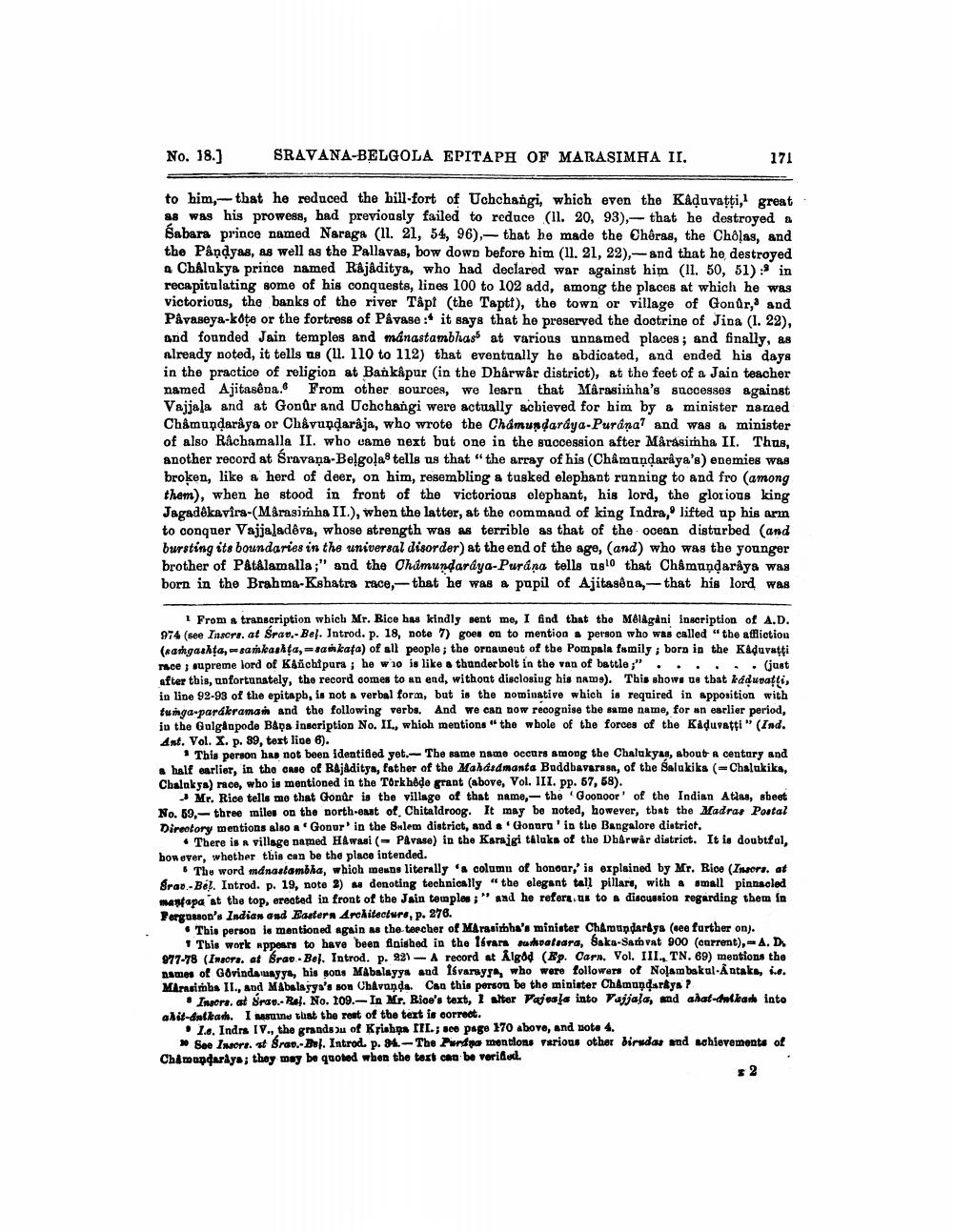________________
No. 18.)
SRAVANA-BELGOLA EPITAPH OF MARASIMHA II.
171
to him, that he reduced the hill-fort of Uchchangi, which even the Kaduvatti, great. 88 was his prowess, had previously failed to reduce (1l. 20, 93), - that he destroyed a Sabara prince named Naraga (11. 21, 54, 96), - that he made the Chêras, the Cholas, and the Påndyas, as well as the Pallavas, bow down before him (11. 21, 22), and that he destroyed a Chalukya prince named Rajaditya, who had declared war against him (11. 50, 51) * in recapitulating some of his conquests, lines 100 to 102 add, among the places at which he was victorious, the banks of the river Tåpt (the Tapti), the town or village of Gonůr, and Pâvaseya-kote or the fortress of Påvase :" it says that he preserved the doctrine of Jina (1. 22), and founded Jain temples and manastambhas at various unnamed places; and finally, as already noted, it tells as (11. 110 to 112) that eventually he abdicated, and ended his days in the practice of religion at Bankåpur (in the Dharwêr district), at the feet of a Jain teacher named Ajitasena. From other sources, we learn that Marasimha's successes against Vajjala and at Gonur and Uchchangi were actually achieved for him by a minister nared Chåmandaraya or Chêvupparâja, who wrote the Chamundaraya-Purana? and was a minister of also Rachamalla II. who came next but one in the succession after Mårasimha II. Thus, another record at Sravana-Belgoļa tells us that "the array of his (Chamundarya's) enemies was broken, like a herd of deer, on him, resembling a tusked elephant running to and fro (among tham), when he stood in front of the victorious elephant, his lord, the glorious king Jagadôkavira-(Marasimha II.), when the latter, at the command of king Indra, lifted up his arm to conquer Vajjaladeva, whose strength was as terrible as that of the ocean disturbed (and bursting its boundaries in the universal disorder) at the end of the age, (and) who was the younger brother of PatAlamalla ;" and the Chamundaraya-Purana tells us that Ch&mundarâys was born in the Brahma-Kshatra race,-that he was a pupil of Ajitas na,--that his lord was
I From a transcription which Mr. Rice has kindly sent me, I find that the Mélagani inscription of A.D. 974 (see Inscrs. at Srao-Bel. Introd. p. 18, note 7) goes on to mention a person who was called "the affliction (Rangasta, =sankashta,=san kata) of all people; the ornament of the Pompala family ; born in the Kaduvatti
ce supreme lord of Kenchipura ; he who is like a thunderbolt in the van of battle;" . . . . . . (just after this, anfortunately, the record comes to an end, without disclosiug his nams). This shows us that keduvatti, in line 92-93 of the epitapb, is not a verbal form, but is the nominative which is required in apposition with tunga-parákramania and the following verbs. And we can now recognise the same name, for an earlier period, in the Gulganpode Bapa insoription No. II, which mentions "the whole of the forces of the Kiduvatti" (Ind. Ant. Vol. X. p. 89, text lige 6).
This person has not been identified yet. The same name occurs among the Chalukyas, about a centary and hall earlier, in the case of BajAditya, father of the Maldsdmanta Buddbavarssa, of the Salukiks (-Chalukika, Chalukya) raco, who is mentioned in the Torkhede grant (above, Vol. III. PP. 57, 58).
Mr. Rice tells me that Gonar is the village of that name,- the Goonoor' of the Indian Atlas, sbeet No. 59,-three miles on the north-east of Chitaldroog. It may be noted, however, that the Madrar Portal Directory mentions also a Gonur' in the Sulem district, and .' Gonura ' in the Bangalore district.
There is a village named HAwasi (- PAvase) in the Karaigi taluks of the Dharwår district. It is doubtful, however, whether this can be the place intended.
The word midnastambha, which means literally '& columu of honour,' is explained by Mr. Rice (Incore, at Srav - Bil. Introd. p. 19, note 3) es denoting technically "the elegant tall pillars, with a small pinnacled mantapa at the top, erected in front of the Jain temples ; " and he refor us to a discussion regarding them in Perguson's Indian and Eastern Architecture, p. 276.
• This person is mentioned again as the torcher of Marasimha's minister Chamundarkys (uee further on).
+ This work appears to have been finished in the 1svars survatsara, Saka-Samvat 900 (current), -A.D. 977-78 (Inaora. at Brav. Bel. Introd. p. 22) - A record at Algod (kp. Oars. Vol. III., TN. 69) mentions the Dames of Govinda unyye, his sons MAbalayya and Isvarsys who were followers of Nolam bakul-Antaks, 1.. Marnaimba II., and Mabalayys's son Chavanda. Can this person be the minister ChAmundarkys?
Ingore, at Srao.- Rel. No. 109.-In Mr. Rioo's text, I alter Vafea la into Vajjala, and a hal-Ankar into abit-dulkad. I m ind that the rest of the text is correct.
• I.e. Indrs IV., the grands pu of Krishna III., see page 170 above, and note 4.
* See more. Srad.- Bul. Introd. p. 8.-The Pundpa mentions various other birudas and achievements of Chlmandardys; thoy may be quoted when the text can be verilud.
I 2




